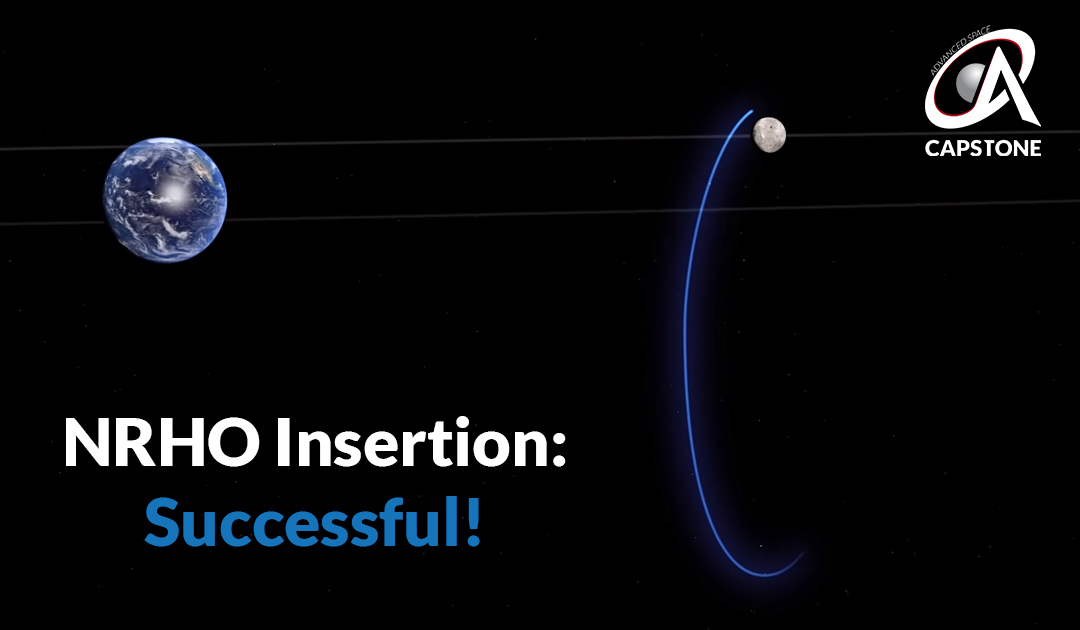First spacecraft to enter the orbit for Gateway arrives to support NASA’s Artemis program.
Westminster, CO — Advanced Space LLC., a leading space tech solutions company, announced CAPSTONE successfully completed the initial insertion maneuver into a Near Rectilinear Halo Orbit (NRHO) on Sunday, November 13th. Two smaller correction maneuvers will take place this week to ensure the spacecraft is confirmed into the complex lunar orbit. This NRHO is an orbit around the Moon that has never been flown before, and it is the intended orbit for the Gateway space station. NASA intends to use Gateway to support Artemis missions to the lunar surface. CAPSTONE is demonstrating how to get into this orbit; in the weeks to come, CAPSTONE will demonstrate and verify orbital operations in the NRHO for NASA. CAPSTONE is reducing risk for future spacecraft.
The Cislunar Autonomous Positioning System Technology Operations and Navigation Experiment or CAPSTONE, is owned and operated by Advanced Space and was built by Terran Orbital. CAPSTONE is the first CubeSat to fly to and operate at the Moon. The spacecraft was launched on June 28th by Rocket Lab, as an early launch supporting the Artemis program. The primary mission is planned for 6 months of operations orbiting the Moon, with extended mission opportunities in the following twelve months.
In addition to the orbit demonstration for Gateway, a primary mission objective is to demonstrate autonomous spacecraft-to-spacecraft navigation services that will allow future spacecraft to determine their location in space without relying exclusively on tracking from Earth. This breakthrough navigation technology has been developed by Advanced Space and is called CAPS™, the Cislunar Autonomous Positioning System.
“We did it! This was the most critical event of the entire mission. Waiting with the team to get confirmation of the insertion maneuver was both a privilege and extremely stressful. It is an honor beyond description to be a part of returning the U.S. to the Moon.” said Bradley Cheetham, Advanced Space Chief Executive Officer and CAPSTONE Principal Investigator. “This is an experience of a lifetime and I’m extremely proud of and grateful for the teamwork of the CAPSTONE mission team and NASA. We have a lot still to do at the Moon, but this was a big accomplishment.”
About CAPSTONE™: CAPSTONE Press Kit
CAPSTONE™ is owned and operated by Advanced Space. It will be one of the first CubeSats to fly in cislunar space – the orbital area near and around the Moon – and demonstrate an innovative spacecraft-to-spacecraft navigation technology. The mission launched on June 28, 2022. Critical partners in the CAPSTONE mission include:
- NASA: CAPSTONE’s development is supported by the Space Technology Mission Directorate via the Small Spacecraft Technology and Small Business Innovation Research programs at NASA’s Ames Research Center in California’s Silicon Valley. The Artemis Campaign Development Division within NASA’s Exploration Systems Development Mission Directorate supported the launch and mission operations. NASA’s Launch Services Program at Kennedy Space Center in Florida was responsible for launch management. NASA’s Jet Propulsion Laboratory supported the communication, tracking, and telemetry downlink via NASA’s Deep Space Network, Iris radio design and groundbreaking 1-way navigation algorithms.
- Terran Orbital Corporation: Spacecraft design, development and implementation, hardware manufacturing, assembly, testing and mission operations support.
- Stellar Exploration: Propulsion subsystem provider.
- Rocket Lab USA, Inc.: Launch provider for CAPSTONE on a three-stage Electron launch vehicle.
- Space Dynamics Lab (SDL): Iris radio and navigation firmware provider.
- Orion Space Solutions (formerly Astra): Chip Scale Atomic Clock (CSAC) hardware provider necessary for the 1-way ranging experiment.
- Tethers Unlimited, Inc.: Cross Link radio provider.
- Morehead State University (MSU): Operates an affiliated node on the NASA Deep Space Network (DSN). Providing telemetry, tracking and control services for NASA and commercial space missions and to engage university students in deep space mission operations.
